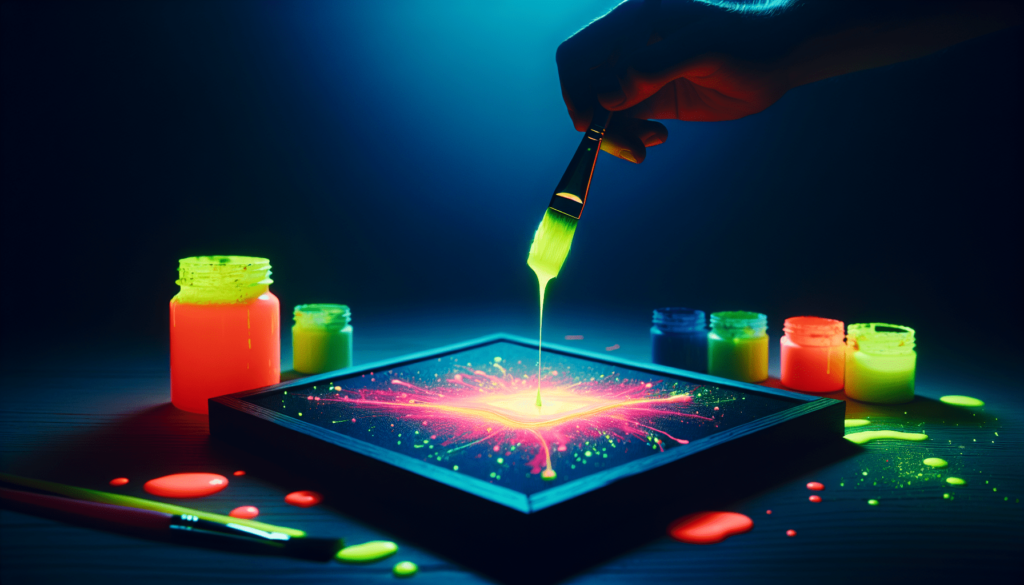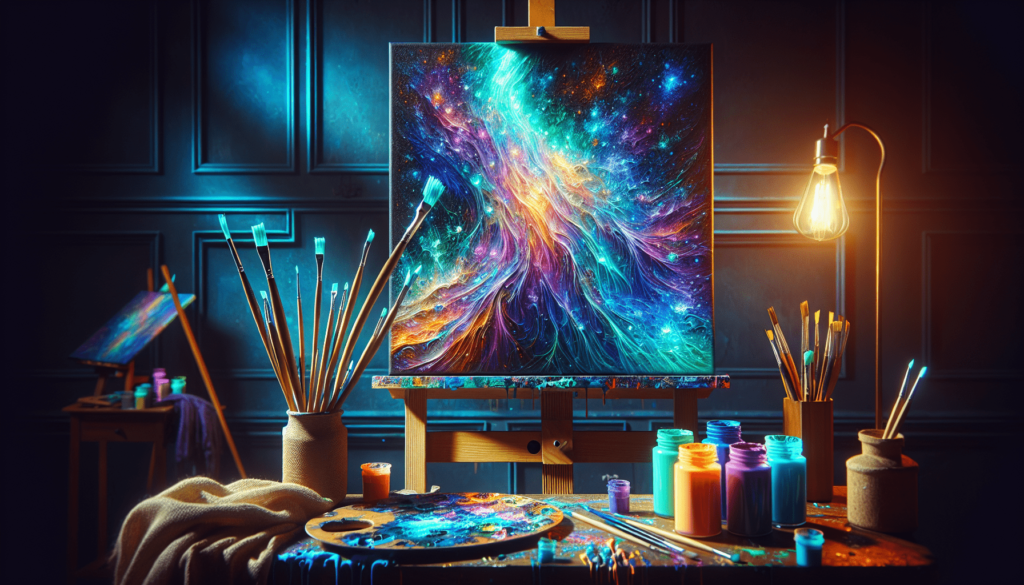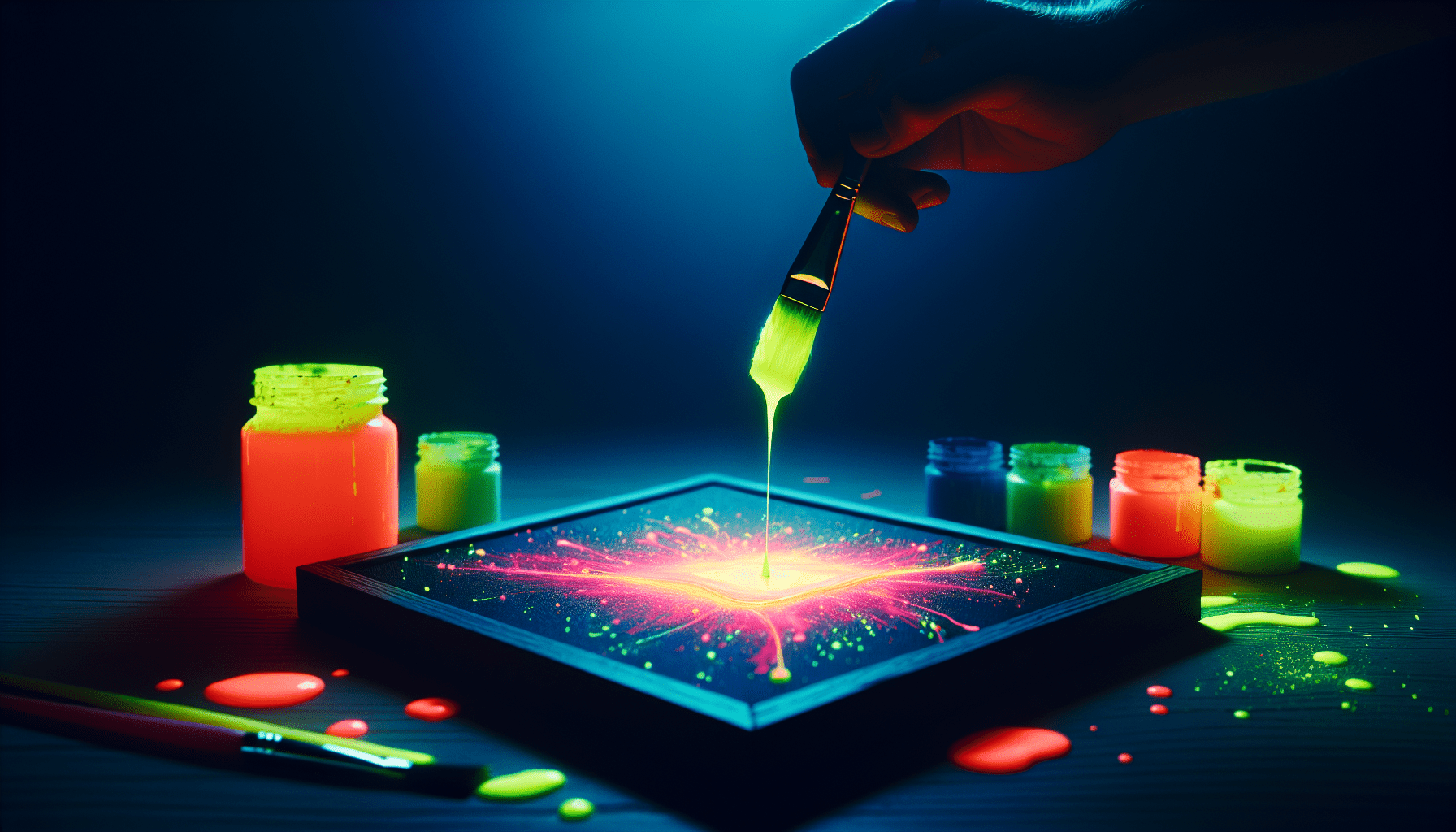In this article, you will learn the essential techniques for creating vibrant and luminous paintings using fluorescent paint on canvas. By understanding the unique properties of fluorescent paint and mastering the correct application methods, you will be able to transform your artwork into a stunning visual spectacle. Whether you are an experienced artist looking to explore new possibilities or a beginner eager to embrace the captivating world of fluorescent paints, this guide will equip you with the knowledge and skills needed to create captivating and mesmerizing artworks that truly come to life.
Choosing the right materials
When embarking on a project to paint with fluorescent paint on canvas, it is crucial to start with the right materials. The choice of fluorescent paint will greatly impact the final result of your artwork. Look for high-quality, artist-grade fluorescent paint that offers vibrant and long-lasting colors. Consider factors such as opacity, lightfastness, and compatibility with other materials you may be using in your artwork.
Alongside selecting the appropriate fluorescent paint, choosing the right canvas is equally important. Opt for a high-quality canvas that is specifically designed for acrylic or oil painting. The canvas should be properly primed to ensure that the paint adheres well and doesn’t bleed through. Additionally, consider the size and shape of the canvas, depending on the composition and dimensions of the artwork you envision.
Gathering the necessary tools and supplies is the next step in preparing for your fluorescent painting project. Apart from the obvious items like paintbrushes and a palette, you may also need additional tools such as stencils or templates for creating specific designs or patterns. Ensure that you have a suitable workspace with good lighting, as this will greatly aid in the painting process. With the right materials at hand, you can proceed to the next step.
Preparing the canvas
Before applying fluorescent paint to the canvas, it is crucial to properly prepare the surface. Start by cleaning the canvas with a soft cloth or sponge to remove any dust, debris, or previous layers of paint. This will help ensure a smooth and even application of the fluorescent paint.
Once the canvas is clean, it is recommended to apply a base coat. This will provide a solid foundation for the fluorescent paint and enhance the vibrancy of the colors. Choose a base color that complements the fluorescent paint you plan to use. Apply the base coat evenly using a brush or roller and allow it to dry completely before moving on to the next step.

Creating a design
Developing a design is an essential part of any artwork, and working with fluorescent paint on canvas is no different. Start by sketching out your design on the canvas using a pencil or charcoal. This initial sketch will serve as a guide for the subsequent steps.
You may also consider using stencils or templates to create specific shapes or patterns in your artwork. Stencils can be a convenient tool for achieving precise and consistent designs. Experiment with different compositions and arrangements until you find the one that best showcases your artistic vision.
Mixing fluorescent paint
Understanding color theory is crucial when working with fluorescent paint. Fluorescent colors can behave differently compared to conventional paints, so it is important to experiment and familiarize yourself with their properties. Start by observing how different colors interact with each other and how they appear under different lighting conditions.
Using a palette is essential for mixing fluorescent paint. Start with the primary colors (red, blue, and yellow) and gradually mix them to create a wide range of shades and hues. Keep in mind that fluorescent colors can be intense, so it is recommended to start with small amounts of paint and gradually add more as needed.
Don’t be afraid to get creative and create custom shades by mixing different fluorescent colors together. By exploring the possibilities, you can achieve unique and captivating effects in your artwork.

Applying the paint
When it comes to applying fluorescent paint, using a brush is a popular choice among artists. Select brushes of various sizes to achieve different textures and strokes. Experiment with different brush techniques such as stippling, blending, or dry brushing to add depth and dimension to your artwork.
To achieve the desired vibrancy and intensity of fluorescent colors, it is often necessary to apply multiple layers of paint. Allow each layer to dry completely before applying the next one. This will prevent the colors from blending and ensure that each layer maintains its distinctiveness.
In addition to brush techniques, consider adding texture to your artwork using other tools or materials. Explore alternative methods such as palette knives, sponges, or even your fingers to achieve unique and interesting effects with fluorescent paint.
Working with fluorescent pigments
Fluorescent pigments possess unique properties that can enhance the visual impact of your artwork. These pigments have the ability to emit light when exposed to specific wavelengths, resulting in a vibrant and ethereal glow. Understanding the characteristics of fluorescent pigments is essential to fully exploit their potential.
To utilize different application techniques, consider applying fluorescent pigments alongside other paints or mediums. Experiment with layering techniques, such as glazing or dry brushing, to create intriguing visual effects. By combining fluorescent pigments with different mediums, you can push the boundaries of creativity and achieve truly captivating results.
Experimenting with different lighting conditions is also crucial when working with fluorescent pigments. These paints come to life under blacklight or ultraviolet (UV) light. Consider incorporating UV lighting fixtures in your workspace or explore alternative lighting options to showcase the full potential of your fluorescent paintings.
Adding finishing touches
Once you have completed the main composition of your fluorescent artwork, it’s time to add the finishing touches. Enhance the details of your design by adding highlights and shadows to create depth and realism. This can be achieved by using lighter or darker shades of fluorescent paint or by incorporating other non-fluorescent paints.
After perfecting the details, don’t forget to sign your artwork. Adding your signature adds a personal touch and indicates that the artwork is your creation. Finally, consider applying a varnish to protect the fluorescent paint and ensure its longevity. Choose a varnish that is compatible with acrylic or oil paints to provide a protective barrier against dust, UV light, and other potential hazards.
Caring for fluorescent paintings
To ensure the longevity of your fluorescent artwork, it is important to take proper care of it. Protecting the painting from direct sunlight is crucial, as prolonged exposure to sunlight can cause the colors to fade over time. Display your artwork in a location away from direct sunlight or use UV-resistant glass if displaying it near a window.
When it comes to storage and transportation, handle the artwork with care to avoid any damage. Store the painting in a cool and dry environment to prevent the paint from cracking or peeling. If you need to transport the artwork, use protective packaging to prevent any mishaps.
Regular cleaning and maintenance are also essential for preserving the vibrancy of your fluorescent paintings. Dust the surface of the painting gently with a soft cloth or brush to remove any accumulated dirt. Avoid using harsh chemicals or abrasive materials, as they can damage the paint.
Displaying fluorescent artwork
Choosing suitable lighting is crucial to showcase the full potential of fluorescent artwork. Consider installing blacklight fixtures or using UV LED lighting to create a mesmerizing glow. Experiment with different angles and intensities of light to highlight specific areas of your artwork.
When it comes to displaying options, consider using a combination of traditional frames and unconventional methods. Traditional frames can provide a classic and elegant presentation, while unconventional methods such as mounting the canvas on a custom-built frame or utilizing shadow boxes can add a modern and artistic touch. The choice of display option should complement the overall aesthetics of your fluorescent artwork.
Experimenting and exploring
The world of fluorescent painting is ripe with opportunities for experimentation and exploration. Don’t be afraid to try different techniques and push the boundaries of creativity. Explore the possibilities of mixing fluorescent paint with other mediums such as pastels, charcoal, or even digital art. By venturing into uncharted territories, you can discover new and captivating ways to utilize fluorescent paint and create truly unique and inspiring artwork.
In conclusion, painting with fluorescent paint on canvas requires careful consideration of materials, proper preparation of the canvas, and a thorough understanding of color theory and application techniques. By following the steps outlined in this article, you can embark on a journey of creativity, producing vibrant and captivating fluorescent artwork. Remember to care for your paintings, choose suitable display options, and always embrace the spirit of experimentation and exploration.



